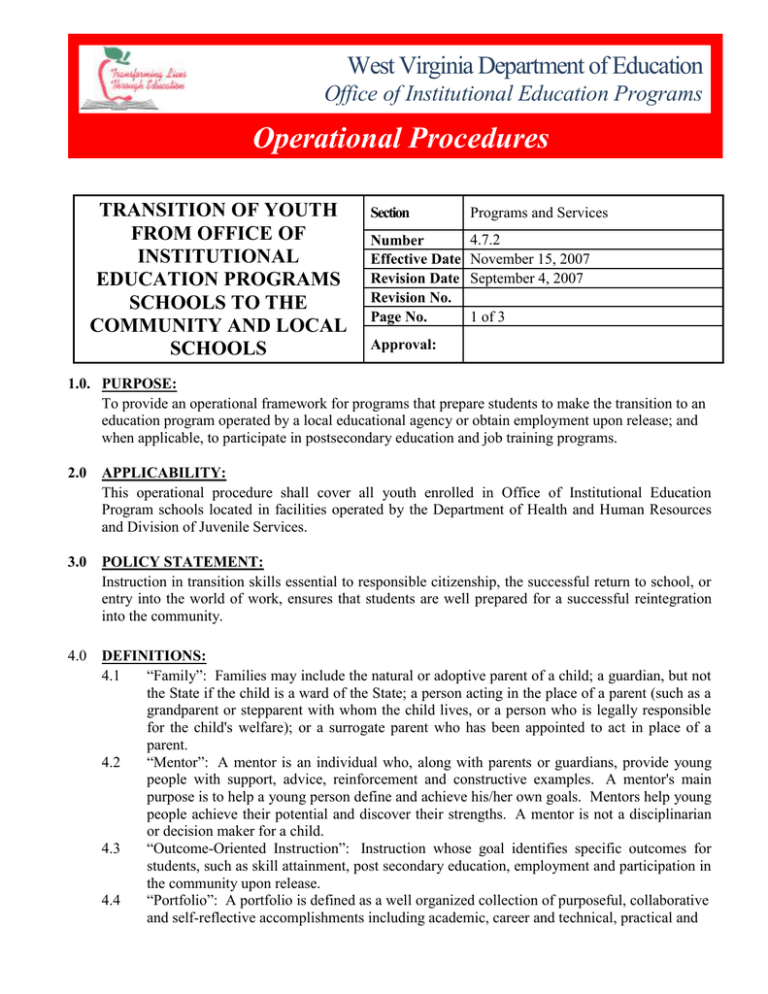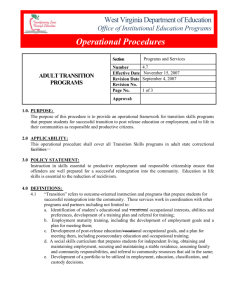Operational Procedures West Virginia Department of Education Office of Institutional Education Programs
advertisement

West Virginia Department of Education Office of Institutional Education Programs Operational Procedures TRANSITION OF YOUTH FROM OFFICE OF INSTITUTIONAL EDUCATION PROGRAMS SCHOOLS TO THE COMMUNITY AND LOCAL SCHOOLS Section Programs and Services Number Effective Date Revision Date Revision No. Page No. 4.7.2 November 15, 2007 September 4, 2007 1 of 3 Approval: 1.0. PURPOSE: To provide an operational framework for programs that prepare students to make the transition to an education program operated by a local educational agency or obtain employment upon release; and when applicable, to participate in postsecondary education and job training programs. 2.0 APPLICABILITY: This operational procedure shall cover all youth enrolled in Office of Institutional Education Program schools located in facilities operated by the Department of Health and Human Resources and Division of Juvenile Services. 3.0 POLICY STATEMENT: Instruction in transition skills essential to responsible citizenship, the successful return to school, or entry into the world of work, ensures that students are well prepared for a successful reintegration into the community. 4.0 DEFINITIONS: 4.1 “Family”: Families may include the natural or adoptive parent of a child; a guardian, but not the State if the child is a ward of the State; a person acting in the place of a parent (such as a grandparent or stepparent with whom the child lives, or a person who is legally responsible for the child's welfare); or a surrogate parent who has been appointed to act in place of a parent. 4.2 “Mentor”: A mentor is an individual who, along with parents or guardians, provide young people with support, advice, reinforcement and constructive examples. A mentor's main purpose is to help a young person define and achieve his/her own goals. Mentors help young people achieve their potential and discover their strengths. A mentor is not a disciplinarian or decision maker for a child. 4.3 “Outcome-Oriented Instruction”: Instruction whose goal identifies specific outcomes for students, such as skill attainment, post secondary education, employment and participation in the community upon release. 4.4 “Portfolio”: A portfolio is defined as a well organized collection of purposeful, collaborative and self-reflective accomplishments including academic, career and technical, practical and TRANSITION OF YOUTH FROM OFFICE OF INSTITUTIONAL EDUCATION PROGRAMS SCHOOLS TO THE COMMUNITY AND LOCAL SCHOOLS Section Programs and Services 4.7.2 Number Effective Date November 15, 2007 Revision Date September 4, 2007 Revision No. Page 2 of 3 Page No. therapeutic treatment intervention. It demonstrates to host agency authorities, receiving education organizations and prospective employers the student’s development, achievements and progress over time 4.5 “Postsecondary Education”: All instruction provided for persons who have completed secondary education or who have discontinued secondary education and are beyond the age of compulsory school attendance. 4.6 “Transition”: Outcome-oriented instruction and services provided to students to prepare for successful re-entry into the community that works in coordination with other programs and partners, including but not limited to: Identification of students’ educational and vocational interests, abilities and preferences; Employment maturity training, including the development of employment goals, a plan for meeting them, and referral for further technical training; Development of post-release education goals, and a plan for meeting them, including adult and postsecondary education; A social skills curriculum that prepares students for independent living, obtaining and maintaining employment, securing and maintaining a stable residence, assuming family and community responsibilities and referral to community resources that aid in the same. Development of a portfolio to be utilized in employment, education, classification, and custody decisions. “Individualized Student Transition Plan” (ISTP) - A plan developed from each youth’s strengths, barriers, interests and short and long term life goals. The transition plan should include input from key partners including but not limited to: the parent/guardian, host agency, Department of Health and Human Resources, Division of Rehabilitation Services, receiving education organization personnel, mentor, probation, WorkForce WV and aftercare treatment agencies where applicable. The transition plan is not a prescriptive set of pursuits rather a mechanism which provides collective recommendations for the youth’s successful transition back into their community. 4.7 5.0 PROCEDURES: 5.1 Transition services shall be offered to all students including those who have finished the requirements to complete their high school diploma or who have passed the General Education Development (GED). 5.2 Institutional Education Programs shall designate an individual to be responsible for issues relating to the transition of students to locally operated programs. 5.3 Institutional Education Programs will work with students to identify educational and career and technical interests, abilities and preferences, and learning styles. 5.4 Institutional Education Programs will offer the OIEP approved social skills curriculum, Achieving Change Through Transition Skills (ACTS), to prepare students for independent TRANSITION OF YOUTH FROM OFFICE OF INSTITUTIONAL EDUCATION PROGRAMS SCHOOLS TO THE COMMUNITY AND LOCAL SCHOOLS 5.5 5.6 5.7 5.8 5.9 5.10 5.11 5.12 5.13 6.0 Section Programs and Services 4.7.2 Number Effective Date November 15, 2007 Revision Date September 4, 2007 Revision No. Page 3 of 3 Page No. living, obtaining and maintaining employment, securing and maintaining a stable residence, and meeting family and community responsibilities. Students will complete, at a minimum, the units Cognitive Education and Transition. Students will be provided, in facilities where available, prescribed assessments in social skills and cognitive reasoning. Grouping students for instruction according to identified need is recommended. Staff shall assist students in the development of post-release education plans, including reentry to public schools, adult and postsecondary education. Where appropriate, Institutional Education Programs shall conduct employment maturity training, including the development of employment plans. Students shall develop portfolios that may be utilized in employment, education, host-agency classification, and custody decisions. Staff shall, through collaborative planning, work with key partners to develop meaningful, individualized student transition plans. Staff shall include families in the development of individualized student transition plans when possible. Staff shall facilitate student enrollment prior to their reentry into public schools. Students will attend such pre-registrations unless prohibited. Staff shall refer students for further educational services post-release. Staff shall provide referrals to appropriate community resources. ACTS instructors shall participate, as required by Office of Institutional Education Programs, in staff professional development in both curriculum content and teaching methodologies. AUTHORITY 6.1 State Board of Education Policy 2800 – Regulations for the Education of Juveniles placed in secure pre-dispositional detention centers. 6.2 State Board of Education Policy 2510- Assuring the Quality of Education: Regulations for Education Programs Section 5.6.4





